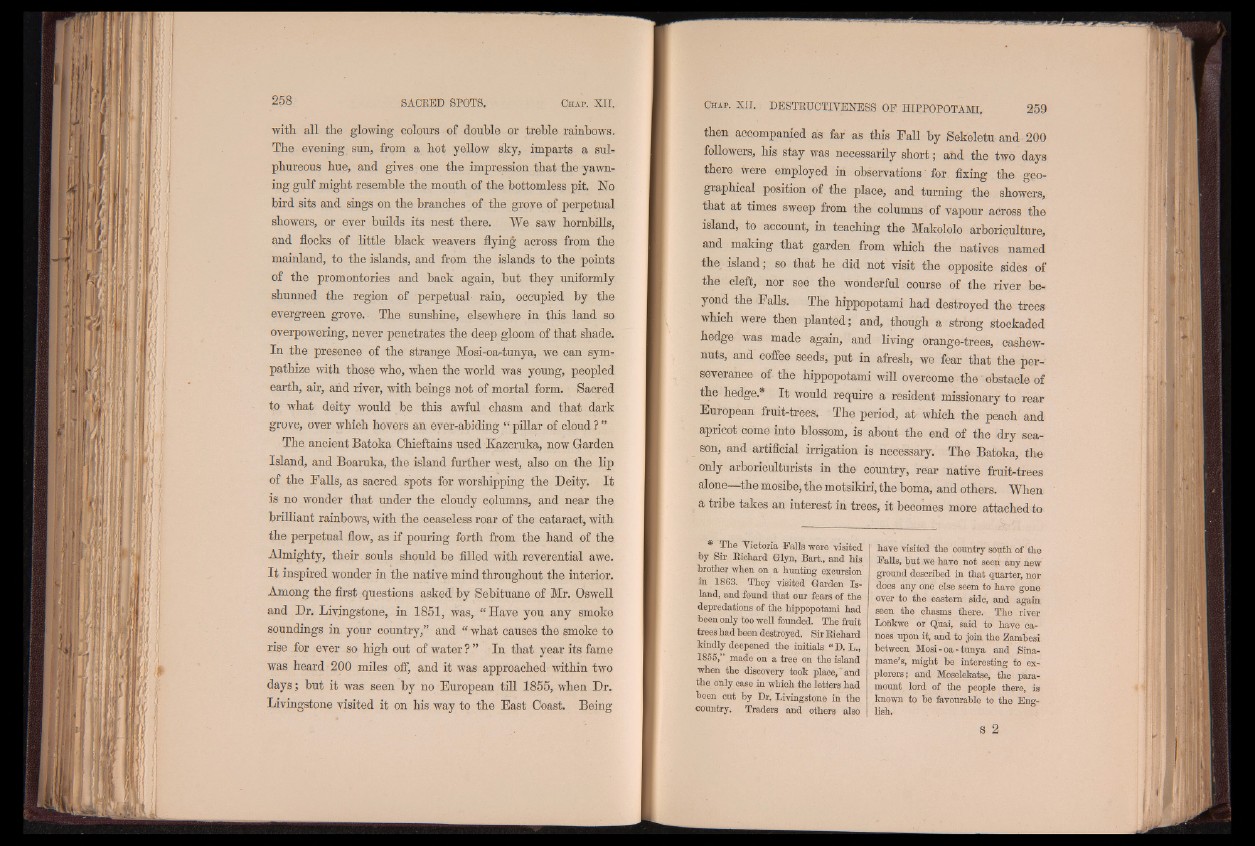
with all the glowing colours of double or treble rainbows.
The evening sun, from a hot yellow sky, imparts a sulphureous
hue, and gives one the impression that the yawning
gulf might resemble the mouth of the bottomless pit. No
bird sits and sings on the branches of the grove of perpetual
showers, or ever builds its nest there. We saw hombills,
and flocks of little black weavers flying across from the
mainland, to the islands, and from the islands to the points
of the promontories and back again, but they uniformly
shunned the region of perpetual rain, occupied by the
evergreen grove.- The sunshine, elsewhere in this land so
overpowering, never penetrates the deep gloom of that shade.
In the presence of the strange Mosi-oa-tunya, we can sympathize
with those who, when the world was young, peopled
earth, air, and river, with beings not of mortal form. Sacred
to what deity would be this awful chasm and that dark
grove, over which hovers an ever-abiding “ pillar of cloud ?”
The ancient Batoka Chieftains used Kazeruka, now Garden
Island, and Boaruka, the island further west, also on the lip
of the Falls, as sacred spots for worshipping the Deity. I t
is no wonder that under the cloudy columns, and near the
brilliant rainbows, with the ceaseless roar of the cataract, with
the perpetual flow, as if pouring forth from the hand of the
Almighty, their souls should be filled with reverential awe.
I t inspired wonder in the native mind throughout the interior.
Among the first questions asked by Sebituane of Mr. Oswell
and Dr. Livingstone, in 1851, was, “ Have you any smoke
soundings in your country,” and “ what causes the smoke to
rise for ever so high out of water?” In that year its fame
was heard 200 miles off, and it was approached within two
days; but it was seen by no European till 1855, when Dr.
Livingstone visited it on his way to the East Coast. Being
then accompanied as far as this Fall by Sekeletu and 200
followers, his stay was necessarily short; and the two days
there were employed in observations' for fixing the geographical
position of the place, and turning the showers,
that at times sweep from the columns of vapour across the
island, to account, in teaching the Makololo arboriculture,
and making that garden from which the natives named
the island; so that he did not visit the opposite sides of
the cleft, nor see the wonderful course of the river beyond
the Falls. The hippopotami had destroyed the trees
which were then planted; and, though a strong stockaded
hedge was made again, and living orange-trees, cashew-
nuts, and coffee seeds, put in afresh, we fear that the perseverance
of the hippopotami will overcome the ‘ obstacle of
the hedge.* I t would require a resident missionary to rear
European fruit-trees. The period, at which the peach and
apricot come into blossom, is about the end of the dry sea-
son, and artificial irrigation is necessary. The Batoka, the
only arboriculturists in the country, rear native fruit-trees
alone—the mosibe, the motsikiri, the boma, and others. When
a tribe takes an interest in trees, it becomes more attached to
* The Victoria Falls were visited
by Sir Richard Glyn, Bart., and his
brother when on a hunting excursion
in 1863. They visited Garden Island,
and found that our fears of the
depredations of the hippopotami had
been only too well founded. The fruit
trees had been destroyed. Sir Richard
kindly deepened the initials “ D. L.,
1855,” made on a tree on the island
when the discovery took place,‘ and
the only case in which the letters had
been cut by Dr. Livingstone in the
country. Traders and others also
have visited the country south of the
Falls, but we have not seen any new
ground described in that quarter, nor
does any one else seem to have gone
over to the eastern side, and again
seen the chasms there. The river
Lofikwe or Quai, said to have canoes
upon it, and to join the Zambesi
between Mosi-oa-tunya and Sina-
mane’s, might be interesting to explorers;
and Moselekatse, the paramount
lord of the people there, is
known to be favourable to the English.